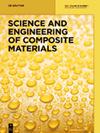纤维素纳米纤维对脱层碳纤维增强聚合物复合材料弯曲性能的影响
IF 1.6
4区 材料科学
Q3 Materials Science
引用次数: 0
摘要
摘要了解分层缺陷对碳纤维增强聚合物(CFRP)损伤演化行为的影响对于提高其工程应用至关重要。本研究采用声发射(AE)和X射线显微计算机断层扫描(micro-CT)相结合的方法研究了CFRP复合材料的弯曲损伤行为。具有不同分层缺陷的四个试样,0.1 对wt%的纤维素纳米纤维(CNFs)进行三点弯曲试验。采用AE监测加载过程,然后利用显微CT检测内部损伤。结果表明,对于表面附近预设有分层缺陷的试件,CNF增强试件对弯曲强度没有明显的增强作用,其累积声能比CFRP试件降低了28%。对于中间位置存在预设分层损伤的试件,CNFs对力学性能有明显的增强作用,累计声能降低43%。在CNF增强的试样中没有观察到明显的扭结带,并且在裂纹扩展过程中,很难引起裂纹和分层损伤。微CT的检测结果与声发射的检测结果基本一致,声发射与微CT的结合体现了混合检测系统的优越性。本文章由计算机程序翻译,如有差异,请以英文原文为准。
Effects of cellulose nanofibers on flexural behavior of carbon-fiber-reinforced polymer composites with delamination
Abstract Understanding the influence of delamination defects on the damage evolution behavior of carbon-fiber-reinforced polymers (CFRPs) is crucial to improve their engineering applications. This study examined the flexural damage behaviors of CFRP composites by using a combination of acoustic emission (AE) and X-ray micro-computed tomography (micro-CT). Four specimens with different delamination defects and 0.1 wt% cellulose nanofibers (CNFs) were subjected to three-point bending tests. AE was employed to monitor the loading process, and then, micro-CT was utilized to detect the internal damage. The results showed that for the specimens with preset delamination defects near the surface, CNF-reinforced specimen exhibited no obvious enhancement effect on bending strength, and its cumulative acoustic energy decreased by 28% compared with that of CFRP specimens. For the specimen with preset delamination damage in the middle position, CNFs had an obvious enhancement effect on mechanical behavior, and the cumulative acoustic energy decreased by 43%. No obvious kink band was observed in the CNF-reinforced specimens, and during crack propagation, causing cracking and delamination damage was difficult. The results of micro-CT are consistent with those of AE. The results combined the combination of AE and micro-CT reflect the superiority of the hybrid detection system.
求助全文
通过发布文献求助,成功后即可免费获取论文全文。
去求助
来源期刊

Science and Engineering of Composite Materials
工程技术-材料科学:复合
CiteScore
3.10
自引率
5.30%
发文量
0
审稿时长
4 months
期刊介绍:
Science and Engineering of Composite Materials is a quarterly publication which provides a forum for discussion of all aspects related to the structure and performance under simulated and actual service conditions of composites. The publication covers a variety of subjects, such as macro and micro and nano structure of materials, their mechanics and nanomechanics, the interphase, physical and chemical aging, fatigue, environmental interactions, and process modeling. The interdisciplinary character of the subject as well as the possible development and use of composites for novel and specific applications receives special attention.
 求助内容:
求助内容: 应助结果提醒方式:
应助结果提醒方式:


